Challenging torrential rains countered by cooperative bats in Costa Rica
Merlin and MTBC team members spent 19 days in Costa Rica last November on a filming trip for “Bat City” with its Director and Emmy
 The National Geographic story “Call of the Bloom” has been four years in the making, but it’s finally published! It was conceived in 2010 when Merlin and I heard Ralph Simon, from the University of Ulm, in Germany, present his doctoral research at the 15th International Bat Research Conference, held in Prague. Merlin was immediately fascinated by Ralph’s research on how plants manipulate bat echolocation to attract them, believing it had excellent potential for helping people better appreciate bats. He proposed a collaboration featuring Ralph’s discoveries in a story for National Geographic. Editors liked the idea, and by early November 2011 we began some extraordinarily challenging field work. Ralph Simon was the expert on bat-adapted flowers, Merlin the photographer, Susan McGrath, the assigned science writer, and I was jack-of-all-trades assistant.
The National Geographic story “Call of the Bloom” has been four years in the making, but it’s finally published! It was conceived in 2010 when Merlin and I heard Ralph Simon, from the University of Ulm, in Germany, present his doctoral research at the 15th International Bat Research Conference, held in Prague. Merlin was immediately fascinated by Ralph’s research on how plants manipulate bat echolocation to attract them, believing it had excellent potential for helping people better appreciate bats. He proposed a collaboration featuring Ralph’s discoveries in a story for National Geographic. Editors liked the idea, and by early November 2011 we began some extraordinarily challenging field work. Ralph Simon was the expert on bat-adapted flowers, Merlin the photographer, Susan McGrath, the assigned science writer, and I was jack-of-all-trades assistant.
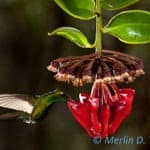
Our initial challenge was to photograph bats pollinating plants that rely on upturned leaves and flower petals that reflect bat echolocation to guide them. The first of these was the rare Marcgravia evenia flowers in Cuba. This plant had been assumed to be pollinated by hummingbirds, though Ralph had discovered that these birds were only stealing nectar. Just three days before our planned departure in mid-April 2011, we learned that our work visas hadn’t yet been approved, forcing a year’s postponement. Though unable to photograph Cuban bats in 2011, Ralph and his hospitable colleagues there double checked to be sure we knew when and where Marcgravia flowers could be found in bloom in 2012.
In the meantime we decided to begin work at the La Selva Biological Station in Costa Rica. On the 10th of November, we had barely gotten Merlin’s photo studio set up and captured four nectar-eating bats, when torrential rains began, and it poured almost continuously for the next three weeks of our stay. Merlin and Ralph quickly tamed the bats so they would ignore us while happily visiting the sea bean (Mucuna holtonii) flowers we brought. Then we built studio sets, indistinguishable from the surrounding forest, in the shelter of our assigned cabina. The bats happily visited our flowers. In fact preventing them from visiting before Merlin could be ready to take pictures was sometimes challenging! Watch Defending the flower on YouTube!
Susan and I were often recruited to help Ralph find blooming plants in the flooded forest, which soon became choked with voracious mosquitoes. We had to locate buds by day, then return after dark with a ladder and long pole clippers to bring them within reach, being careful not to damage them, sometimes while riding a bicycle. Merlin and Ralph would then take a couple of hours to build a set, and photography would begin around 10 PM.
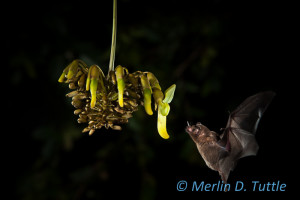
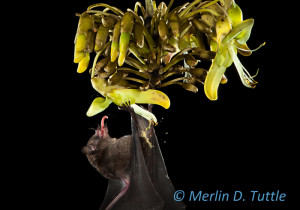 Fortunately, sea bean flowers were relatively abundant. As described by Susan, each flower had a tiny trigger point that must be touched by a bat tongue, causing it to fire pollen onto the bat’s rump. We could never be certain exactly when a flower would fire its pollen, so Merlin could only guess when to trigger his camera and high-speed flashes. It all happened in a tiny fraction of a second. Extreme patience and some 10,000 images were required to finally capture the event.
Fortunately, sea bean flowers were relatively abundant. As described by Susan, each flower had a tiny trigger point that must be touched by a bat tongue, causing it to fire pollen onto the bat’s rump. We could never be certain exactly when a flower would fire its pollen, so Merlin could only guess when to trigger his camera and high-speed flashes. It all happened in a tiny fraction of a second. Extreme patience and some 10,000 images were required to finally capture the event.
When we finally arrived in Cuba on the 6th of March 2012, despite earlier reconnaissance to verify flowering times, most of the flowers weren’t ready to bloom. Desperate, Ralph and his Cuban colleagues, Yayo Reyes and Margarita Sanchez, scoured the countryside to no avail. Finally, in a remote area, they found several plants blooming and excitedly phoned Merlin and me to pack and get ready to move. Then, just as we were ready, Ralph was informed that, though our permits allowed us to visit the new location, they did not permit us to take pictures!
In great dejection, Ralph called us with the news, but suggested we unpack and keep our already tamed bats. He and Yayo would try to bring two flower clusters known as inflorescences, along with substantial set-building material. They would have to hold the stems submerged in water for a several-hour drive over rough roads, but remained hopeful. Merlin and I were terrified that the plants would wilt, and we’d miss our last chance. Luckily, they arrived safely, and we got some great shots of our bats visiting them. We did later find one flowering Marcgravia plant in a mountaintop cloud forest that required a long hike to shoot hummingbird visits between torrential showers.
To complete the story, we still needed to visit Rio Leon Valley in the Andes of Ecuador, home of a unique cactus (Espostoa frutescens) found nowhere else. Ralph and his major professor, Otto von Helrsen, had seen it years earlier and speculated it to be bat-dependent for pollination. They suspected that this rare plant relied on an opposite approach to guiding echo-locating bats, though no one had ever seen any potential pollinator visit it. Since it had not been studied no one had any idea what triggered it to bloom.
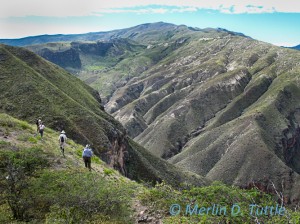 We relied on an Ecuadorian colleague, Vinicio Santillan, to email us when he found flowers. For six months all reports were negative until just a few days after our return from Cuba. We got an email showing photos of the cactus plants flowering. We repacked and arrived in Ecuador in just three days. But none of the plants still showed signs of buds. For a week we scoured the rugged valley for even one plant in bloom, but to no avail. We hiked for miles each day, often descending as much as 1,500 feet vertically on treacherous trails where a fall could have been fatal. By the time Ralph and a Paraguayan colleague, Nery Chamorro, arrived to help, we were quite discouraged.
We relied on an Ecuadorian colleague, Vinicio Santillan, to email us when he found flowers. For six months all reports were negative until just a few days after our return from Cuba. We got an email showing photos of the cactus plants flowering. We repacked and arrived in Ecuador in just three days. But none of the plants still showed signs of buds. For a week we scoured the rugged valley for even one plant in bloom, but to no avail. We hiked for miles each day, often descending as much as 1,500 feet vertically on treacherous trails where a fall could have been fatal. By the time Ralph and a Paraguayan colleague, Nery Chamorro, arrived to help, we were quite discouraged.
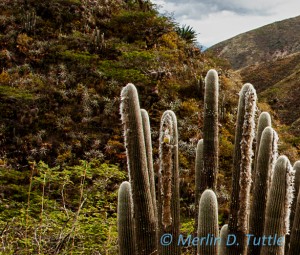 A local shaman, Juan Valdi, suspected that flowering was triggered by the moon, meaning that we might have to wait for a whole month. Even worse, rancher Luis Salazar believed that the plants likely responded to rain, but predicted there would be no more rain for at least three months! Fortunately, Luis appears to have been right about the cactus responding to rain but wrong in his weather forecasting. A day later it began to rain daily. The cactus plants bloomed, and with Luis’ help we found them.
A local shaman, Juan Valdi, suspected that flowering was triggered by the moon, meaning that we might have to wait for a whole month. Even worse, rancher Luis Salazar believed that the plants likely responded to rain, but predicted there would be no more rain for at least three months! Fortunately, Luis appears to have been right about the cactus responding to rain but wrong in his weather forecasting. A day later it began to rain daily. The cactus plants bloomed, and with Luis’ help we found them.
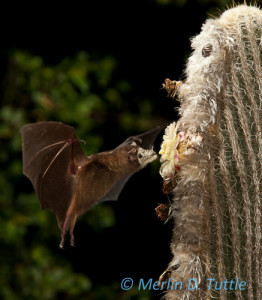 Then came the real suspense. Would the bats we had captured nearby be the right ones to pollinate our cactus? Not yet fully acclimated to working with us, they made us wait for nearly an hour in Merlin’s studio before repeatedly visiting our flower. What a relief!
Then came the real suspense. Would the bats we had captured nearby be the right ones to pollinate our cactus? Not yet fully acclimated to working with us, they made us wait for nearly an hour in Merlin’s studio before repeatedly visiting our flower. What a relief!
In the end, Merlin shot more than 20,000 images for a story that used just five in the magazine version, with several more included online at ngm.com Call of the Bloom
Why work so hard to publish a bat story in National Geographic? Because as Merlin says, “There is no better place to have worldwide impact for bats. Also, the remaining 20,000 as yet unpublished images will be a gold mine for conservationists educating the public about the values of bats.” Here are just a couple of those images:
National Geographic Magazine link to the story Call of the Bloom
National Geographic Daily News link of Merlin’s interview, To Know Bats Is to Love Them
Love our content? Support us by sharing it!
Merlin and MTBC team members spent 19 days in Costa Rica last November on a filming trip for “Bat City” with its Director and Emmy
“Just like the old days, eh Heather?” Kent softly clicks his tally counter as he sits in his folding chair on the other side of
Bats can use sounds in many complex ways. They can sing and even have different dialects… When imagining a bat, the first thoughts that come
It was a long road to Austin, Texas. More than five years after my first introduction to Merlin Tuttle’s Bat Conservation as a teenager, I packed
2024 © Merlin Tuttle’s Bat Conservation. All rights reserved.
Madelline Mathis has a degree in environmental studies from Rollins College and a passion for wildlife conservation. She is an outstanding nature photographer who has worked extensively with Merlin and other MTBC staff studying and photographing bats in Mozambique, Cuba, Costa Rica, and Texas. Following college graduation, she was employed as an environmental specialist for the Florida Department of Environmental Protection. She subsequently founded the Florida chapter of the International DarkSky Association and currently serves on the board of DarkSky Texas. She also serves on the board of Houston Wilderness and was appointed to the Austin Water Resource Community Planning Task Force.
Michael Lazari Karapetian has over twenty years of investment management experience. He has a degree in business management, is a certified NBA agent, and gained early experience as a money manager for the Bank of America where he established model portfolios for high-net-worth clients. In 2003 he founded Lazari Capital Management, Inc. and Lazari Asset Management, Inc. He is President and CIO of both and manages over a half a billion in assets. In his personal time he champions philanthropic causes. He serves on the board of Moravian College and has a strong affinity for wildlife, both funding and volunteering on behalf of endangered species.